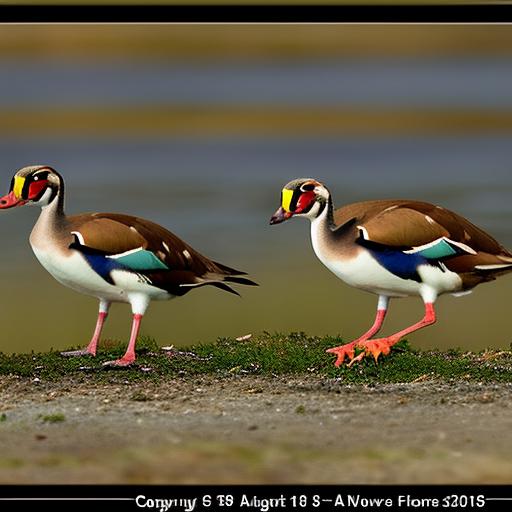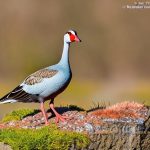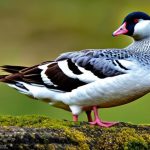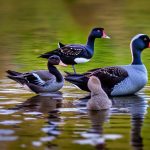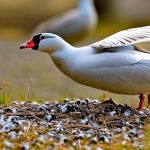The Egyptian Goose, also known as Alopochen aegyptiaca, is a species of waterfowl native to Africa. Despite its name, the Egyptian Goose is not actually native to Egypt, but rather to the Nile Valley and sub-Saharan Africa. These geese are easily recognizable by their striking appearance, with a chestnut brown body, white wing patches, and a distinctive dark eye patch. They are also known for their loud, honking calls, which can often be heard echoing across the waterways where they reside.
Egyptian Geese are primarily found in freshwater habitats such as lakes, rivers, and marshes, where they feed on a diet of grasses, seeds, and aquatic plants. They are also known to forage in agricultural fields and pastures, making them a common sight in both natural and human-altered landscapes. Egyptian Geese are monogamous birds, forming long-term pair bonds with their mates. They are also highly territorial, often aggressively defending their nesting sites from other waterfowl and predators.
The Breeding Season of Egyptian Geese
The breeding season for Egyptian Geese typically begins in late winter or early spring, when the days start to lengthen and the weather begins to warm. During this time, pairs of geese can be seen engaging in elaborate courtship displays, which involve a series of calls, head bobbing, and wing flapping. These displays serve to strengthen the bond between mates and establish their territory in preparation for nesting.
Once a suitable nesting site has been chosen, the female will begin to construct a nest using a combination of grasses, reeds, and other plant materials. The male will often assist in gathering materials and defending the nesting site from potential threats. Egyptian Geese are known for their strong nest-site fidelity, often returning to the same location year after year to raise their young. This behavior helps to ensure the survival of their offspring by selecting nesting sites that have proven to be successful in the past.
Choosing the Right Nesting Site
Selecting the right nesting site is crucial for the successful breeding of Egyptian Geese. They prefer to nest in areas with dense vegetation, such as reed beds or grassy islands, which provide both protection from predators and easy access to food and water. Nesting sites that are located near the water’s edge are also preferred, as this allows the geese to quickly escape into the safety of the water if threatened.
In urban and suburban areas, Egyptian Geese have been known to adapt to nesting in man-made structures such as rooftops, balconies, and even traffic islands. While these sites may not offer the same level of natural protection as traditional nesting sites, they can still provide a safe and secure environment for raising young. However, it is important for humans to be mindful of the presence of nesting geese and to take steps to avoid disturbing them during this critical time.
The Role of Egyptian Goose Mates in Breeding
Both male and female Egyptian Geese play important roles in the breeding process. Once a nesting site has been chosen, the female will begin to construct the nest, using a combination of grasses, reeds, and other plant materials. The male will often assist in gathering materials and defending the nesting site from potential threats. This cooperative behavior helps to ensure the success of the breeding pair and the survival of their offspring.
During the incubation period, which lasts for approximately 28 days, both parents take turns sitting on the nest to keep the eggs warm and protected. This shared responsibility allows the geese to take breaks for feeding and bathing, while still ensuring that the eggs are constantly attended to. Once the eggs hatch, both parents are actively involved in caring for the goslings, providing them with food, protection, and guidance as they grow and develop.
Egg-laying and Incubation Period
After the nest has been constructed, the female will lay a clutch of eggs, typically ranging from 5 to 12 eggs, depending on the age and health of the female. Once the entire clutch has been laid, the incubation period begins, with both parents taking turns sitting on the nest to keep the eggs warm and protected. This shared responsibility allows the geese to take breaks for feeding and bathing, while still ensuring that the eggs are constantly attended to.
The incubation period lasts for approximately 28 days, during which time the eggs are kept at a constant temperature and humidity to ensure successful hatching. The parents will also rotate the eggs regularly to ensure that they receive even heat distribution, which is crucial for the development of the embryos. Once the eggs hatch, the goslings are precocial, meaning that they are born with their eyes open and are able to walk, swim, and feed themselves shortly after hatching.
Caring for Egyptian Goose Goslings
Once the goslings have hatched, both parents are actively involved in caring for them. They provide the young with food, protection, and guidance as they grow and develop. The parents will lead the goslings to suitable feeding areas, where they can forage for grasses, seeds, and aquatic plants. They will also defend the goslings from potential threats, such as predators and other waterfowl, using their loud calls and aggressive behavior to deter any potential danger.
As the goslings grow, they will begin to develop their flight feathers and learn to fly, which is crucial for their survival. The parents will continue to provide guidance and protection until the goslings are fully independent, at which point they will leave the family unit to establish their own territories and begin the breeding process themselves. This cycle of care and independence is crucial for the long-term survival of the Egyptian Goose population.
Predators and Threats to Egyptian Goose Nesting Sites
Despite their aggressive behavior and strong territorial instincts, Egyptian Geese face a number of threats to their nesting sites. Predators such as foxes, raccoons, and birds of prey are known to raid nests and prey on eggs and young goslings. In addition, human disturbance and habitat destruction can also pose significant threats to nesting sites, particularly in urban and suburban areas where development and human activity can disrupt natural habitats.
In some areas, Egyptian Geese have also been targeted by hunters and egg collectors, further threatening their breeding success. In response to these threats, conservation efforts have been implemented to protect nesting sites and raise awareness about the importance of preserving the natural habitats of Egyptian Geese. These efforts aim to reduce human disturbance, control predator populations, and promote the conservation of wetland habitats where geese can thrive.
Conservation Efforts for Egyptian Geese
Conservation efforts for Egyptian Geese focus on protecting nesting sites and preserving the natural habitats where these birds can thrive. This includes the establishment of protected areas and wildlife refuges, where nesting sites are monitored and managed to ensure the success of breeding pairs. In addition, efforts are made to raise awareness about the importance of preserving wetland habitats and reducing human disturbance in areas where geese are known to breed.
Conservation organizations also work to control predator populations and reduce the impact of hunting and egg collecting on Egyptian Geese. This may involve the implementation of predator control measures, such as the removal of invasive species or the use of deterrents to discourage predators from raiding nests. By addressing these threats and promoting the conservation of wetland habitats, conservation efforts aim to ensure the long-term survival of Egyptian Geese and their breeding populations.
Tips for Observing Egyptian Geese During Breeding Season
For birdwatchers and wildlife enthusiasts, observing Egyptian Geese during the breeding season can be a rewarding experience. To minimize disturbance to nesting sites and breeding pairs, it is important to observe these birds from a safe distance and to avoid approaching nesting areas. This can help to reduce stress on the geese and ensure the success of their breeding efforts.
When observing Egyptian Geese, it is important to be mindful of their behavior and to respect their territorial boundaries. This may involve using binoculars or a spotting scope to observe the geese from a distance, rather than approaching them directly. By taking these precautions, birdwatchers can enjoy the sight of these beautiful birds without causing harm or disruption to their breeding activities.
The Importance of Protecting Egyptian Geese Habitats
The preservation of wetland habitats is crucial for the long-term survival of Egyptian Geese and their breeding populations. These habitats provide the food, water, and shelter that geese need to thrive, making them essential for the success of breeding pairs and the survival of their offspring. By protecting wetland habitats, we can ensure that Egyptian Geese have the resources they need to raise their young and maintain healthy populations.
In addition to providing essential resources for breeding geese, wetland habitats also support a wide variety of other wildlife, including fish, amphibians, and other waterfowl. By preserving these habitats, we can help to maintain the biodiversity and ecological balance of these important ecosystems. This benefits not only Egyptian Geese, but also the countless other species that rely on wetlands for their survival. By working to protect and preserve wetland habitats, we can ensure a brighter future for Egyptian Geese and the natural world as a whole.
Meet Walter, the feathered-friend fanatic of Florida! Nestled in the sunshine state, Walter struts through life with his feathered companions, clucking his way to happiness. With a coop that’s fancier than a five-star hotel, he’s the Don Juan of the chicken world. When he’s not teaching his hens to do the cha-cha, you’ll find him in a heated debate with his prized rooster, Sir Clucks-a-Lot. Walter’s poultry passion is no yolk; he’s the sunny-side-up guy you never knew you needed in your flock of friends!

